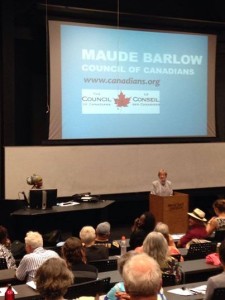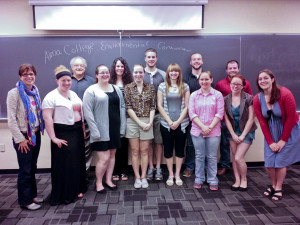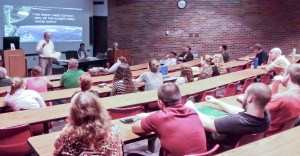On July 1, 2014, FLOW, along with sixteen other conservation, water, and environmental groups and the Little Traverse Bay Bands of Odawa Indians submitted a letter to Michigan Governor Rick Snyder, urging him to address Enbridge’s 61 year-old Line 5 oil pipelines located under the Straits of Mackinac in Lake Michigan-Huron. The letter addressed Enbridge’s lack of transparency and disclosure regarding its current use of Line 5, as well as the Company’s compliance record with the terms and conditions of the 1953 easement and agreements it made under Act 10, P.A. 1953, the Great Lakes Submerged Lands Act (“GLSLA”), and public trust law.
State’s Perpetual Public Trust Duty to Protect Great Lakes
As the State’s primary trustee of the Great Lakes public trust waters and bottomlands, Governor Snyder has the solemn perpetual duty to ensure that the actions of both public and private parties are not likely to harm this shared resource. This means that the State must ensure uninterrupted use for fishing, commerce, navigation, recreation, and drinking supplies for future generations.
Letter’s Requests to the Governor
The signatories have asked that the Governor exercise his broad legal authority to demand that Enbridge:
- Submit the information the Attorney General and the Department of Environmental Quality requested in their joint April 29 letter and make such information available to the public.
- Submit detailed information regarding the product contents, use, and safety of Pipe Line 5.
- File a conveyance application under the GLSLA.
- Achieve full compliance with all express terms and conditions of the easement.
Enbridge’s Track Record
Since 1999, Enbridge has been responsible for over 800 oil spills, leaking a total of 6.8 million gallons of oil into the environment. Michiganders will remember Enbridge’s catastrophic Line 6B pipeline spill along a 35-mile stretch of the Kalamazoo River, discharging some one million gallons of heavy tar sands oil and resulting in a $1 billion cleanup cost. Enbridge’s Lack of Disclosure Raises Questions About Compliance with 1953 Easement Based on Enbridge’s track record and the ecologically sensitive location of Line 5 in the Straits of Mackinac, the signatories urged the State to take swift and meaningful action to ensure full compliance with the terms of the easement and the long-term protection of the Great Lakes. A review of the 1953 easement revealed a lack of transparency, disclosure, and compliance with the following expressed terms and conditions:
- Maximum Operating Pressure (MOP): The MOP of the pipeline is 600 pounds per square inch gauge (psig). Recent data raises questions as to whether or not Enbridge is adhering to this pressure requirement.
- Complete Records of Oil: Under the terms of the easement, The State of Michigan has express authority to require Enbridge to disclose and make available complete records of oil and all other substances being transported in the Line 5 pipelines.
- Maximum Span of Unsupported Pipeline: The records are incomplete as to whether or not Enbridge has complied with the 75 foot maximum span of unsupported pipeline requirement. Enbridge’s recent “maintenance” DEQ permit requests to place anchoring supports on the bottomlands of the lakes raises questions about full compliance with this easement term.
- Maximum Curvature Requirement: Enbridge should disclose current data showing that no section of Line 5 violates the maximum curvature requirement of a 2050 foot radius, as specified in section A(4) of the the 1953 easement.
- Adequacy of Liability Insurance Provision: The term of the easement requires that Enbridge maintain at least $1 million in insurance coverage. However, the $1 billion cost associated with the breach of Line 6B along the Kalamazoo River raises serious questions regarding the sufficiency of the protection offered by the 1953 easement.
The absence of such information – all of which is mandatory though Public Act 10 of 1953, the 1953 easement, the GLSLA, and the public trust doctrine – makes it impossible to truly assess the risks and ramifications of a devastating crude oil spill in the heart of the Great Lakes. Moreover, as trustee of the Great Lakes, the State of Michigan and its agencies have unfettered authority under the GLSLA and public trust law to demand that Enbridge provide such transparency, discloser, accountability, and compliance.
Next Steps
Line 5 is a Michigan and Great Lakes public trust issue, not a partisan one. The time to act is now given the age of the pipeline and Enbridge’s recent efforts to increase Line 5’s capacity and a change in product to synthetic crudes. Public trust authority empowers the state to require Enbridge to disclose all relevant information on Line 5 and provide much needed transparency and accountability. This, in turn, will ensure our common waters are protected for current and future generations.
Given the gravity of this situation, all signatories of the letter have asked to meet with Governor Snyder to discuss the aforementioned desired actions at his earliest convenience. Below is the list of groups that have signed-on to this letter.
- Michigan Environmental Council (MEC)
- For Love of Water (FLOW)
- Environmental Law and Policy Center (ELPC)
- Michigan Land Use Institute
- League of Conservation Voters (LCV)
- Freshwater Future
- Northwest Michigan Environmental Action Council (NMEAC)
- Concerned Citizens of Cheboygan and Emmet Counties
- Article 32.org
- Michigan Citizens for Water Conservation (MCWC)
- Michigan Resource Stewards
- SURF Great Lakes.org
- Straits Area Concerned Citizens for Peace, Justice and the Environment (SACCPJE)
- TC350.org
- The Watershed Center Grand Traverse Bay
- West Michigan Environmental Action Council (WMEAC)
- Little Traverse Bay Bands of Odawa Indians
- Straits Area Audubon Society
Click here to read the letter to Governor Snyder
Click here to read the Press Release
News Articles
 I will be a senior at Michigan State University this fall. My family bleeds green and white, so I have been a Spartan since birth. I am in the James Madison College at MSU majoring in Comparative Cultures and Politics. I am also working towards a minor in Spanish and a Science, Technology, Environment, and Public Policy Specialization. Throughout my time at MSU, I have been a member of the varsity women’s soccer team.
I will be a senior at Michigan State University this fall. My family bleeds green and white, so I have been a Spartan since birth. I am in the James Madison College at MSU majoring in Comparative Cultures and Politics. I am also working towards a minor in Spanish and a Science, Technology, Environment, and Public Policy Specialization. Throughout my time at MSU, I have been a member of the varsity women’s soccer team.




 The joint commission recommends an immediate cut of nearly 50 percent in phosphorus loading from excessive use of farm fertilizers and municipal sewage overflows, through modifications of current practices. It calls for a fresh legal and policy framework for sharing responsibility and achieving the necessary reduction in phosphorus to restore Lake Erie and renew its beaches, fishing, and other natural advantages.
The joint commission recommends an immediate cut of nearly 50 percent in phosphorus loading from excessive use of farm fertilizers and municipal sewage overflows, through modifications of current practices. It calls for a fresh legal and policy framework for sharing responsibility and achieving the necessary reduction in phosphorus to restore Lake Erie and renew its beaches, fishing, and other natural advantages.
